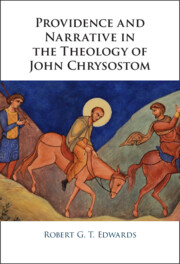Book contents
- Providence and Narrative in the Theology of John Chrysostom
- Providence and Narrative in the Theology of John Chrysostom
- Copyright page
- Dedication
- Epigraph
- Contents
- Preface
- Abbreviations
- 1 Stories of Suffering and Providence
- 2 Divine and Human Activity in Biblical Narrative
- 3 Narrative Clusters, Providential Habits, and Typological Exegesis
- 4 Proofs of Providence and God’s Philanthropic Character
- 5 True Judgements and Consolation
- 6 The Virtue of Yielding to Providence
- 7 Conclusion
- Bibliography
- Scriptural Index
- Subject Index
2 - Divine and Human Activity in Biblical Narrative
Published online by Cambridge University Press: 01 December 2022
- Providence and Narrative in the Theology of John Chrysostom
- Providence and Narrative in the Theology of John Chrysostom
- Copyright page
- Dedication
- Epigraph
- Contents
- Preface
- Abbreviations
- 1 Stories of Suffering and Providence
- 2 Divine and Human Activity in Biblical Narrative
- 3 Narrative Clusters, Providential Habits, and Typological Exegesis
- 4 Proofs of Providence and God’s Philanthropic Character
- 5 True Judgements and Consolation
- 6 The Virtue of Yielding to Providence
- 7 Conclusion
- Bibliography
- Scriptural Index
- Subject Index
Summary
This chapter shows how John Chrysostom characteristically turns to biblical historia to console his suffering audiences. It therefore seeks to define biblical historia to see what is particularly comforting about it, finding that it is best translated as ‘story’ and has narrativity as its essential component, with divine and human activity – providence and virtue and vice – as its central subject matter.
- Type
- Chapter
- Information
- Publisher: Cambridge University PressPrint publication year: 2022

